You’ll discover that Massachusetts’ native plants are practically bulletproof survivors, thriving in everything from coastal salt spray to mountain frost. These hardy species have adapted to the state’s unpredictable weather patterns over thousands of years, making them your best bet for a low-maintenance garden. From vibrant wildflowers that bloom for months to towering maples that’ll outlive your grandchildren, choosing the right natives depends on understanding your specific hardiness zone and soil conditions.
Contents
- 1 Massachusetts’ USDA Hardiness Zones
- 2 Best Native Wildflowers for Massachusetts
- 3 Massachusetts Native Shade Trees
- 4 Massachusetts Native Shrub Varieties
- 5 Selecting the Right Native Plants for Your Garden
- 6 Frequently Asked Questions
- 6.1 When Is the Best Time to Plant Native Species in Massachusetts?
- 6.2 How Do I Propagate Massachusetts Native Plants From Seeds?
- 6.3 What Native Plants Attract Butterflies and Pollinators in Massachusetts?
- 6.4 Are There Native Alternatives to Common Invasive Plants in Massachusetts?
- 6.5 How Much Do Native Massachusetts Plants Typically Cost Compared to Non-Natives?
Massachusetts’ USDA Hardiness Zones
Before you select any native plants for your Massachusetts garden, you’ll need to understand your specific USDA hardiness zone. The state spans zones 5a through 7b, with the Berkshires experiencing the coldest temperatures and Cape Cod enjoying the mildest winters. Climate change impact has shifted many areas toward warmer zones in the recent 2023 update. Eastern Massachusetts falls into zone 7a, while western regions typically range from 5a to 6a. Understanding hardiness zone benefits helps you choose plants that’ll survive winter temperatures, which can drop below zero in colder zones but stay milder near the coast. When shopping for native plants, most nurseries will clearly mark the hardiness zones on plant labels to help you make appropriate selections for your specific location.
Best Native Wildflowers for Massachusetts
Massachusetts offers diverse native wildflowers that thrive in various garden conditions while supporting local pollinators and requiring minimal maintenance for sustainable landscaping success. These wildflowers include goldenrods and beebalms that provide essential nectar sources throughout the growing season.
Wild Bergamot (Monarda Fistulosa)

Wild Bergamot (Monarda fistulosa) is a beautiful native herbaceous perennial that brings exceptional value to Massachusetts gardens. This 2-4 foot tall wildflower produces striking pink to lavender tubular blooms from June through August, filling the air with a distinctive minty fragrance when its leaves and stems are crushed. Beyond its ornamental appeal, Wild Bergamot serves as a pollinator magnet, attracting bees, butterflies, and hummingbirds while supporting native ecosystems.
Historically used by indigenous peoples for medicinal purposes and herbal teas, this versatile plant adapts readily to various growing conditions throughout the state. The species is also valued as a flavoring agent in contemporary culinary applications. Its deer-resistant nature and ability to naturalize in favorable conditions make it a fantastic choice for low-maintenance native gardens, meadow plantings, and restoration projects.
- Hardiness: Zones 3-9, well-suited to Massachusetts climate
- Light: Full sun to partial shade; prefers sunny locations for ideal flowering
- Water: Low to moderate; drought tolerant once established
- Soil: Well-drained loamy or sandy soils; tolerates clay if drainage is adequate
- Fertilizer: None required; thrives in average soils
- Pest/Disease Resistance: Generally resistant to pests; deer resistant
- Growth Rate: Moderate to fast; spreads readily and may naturalize
New England Aster
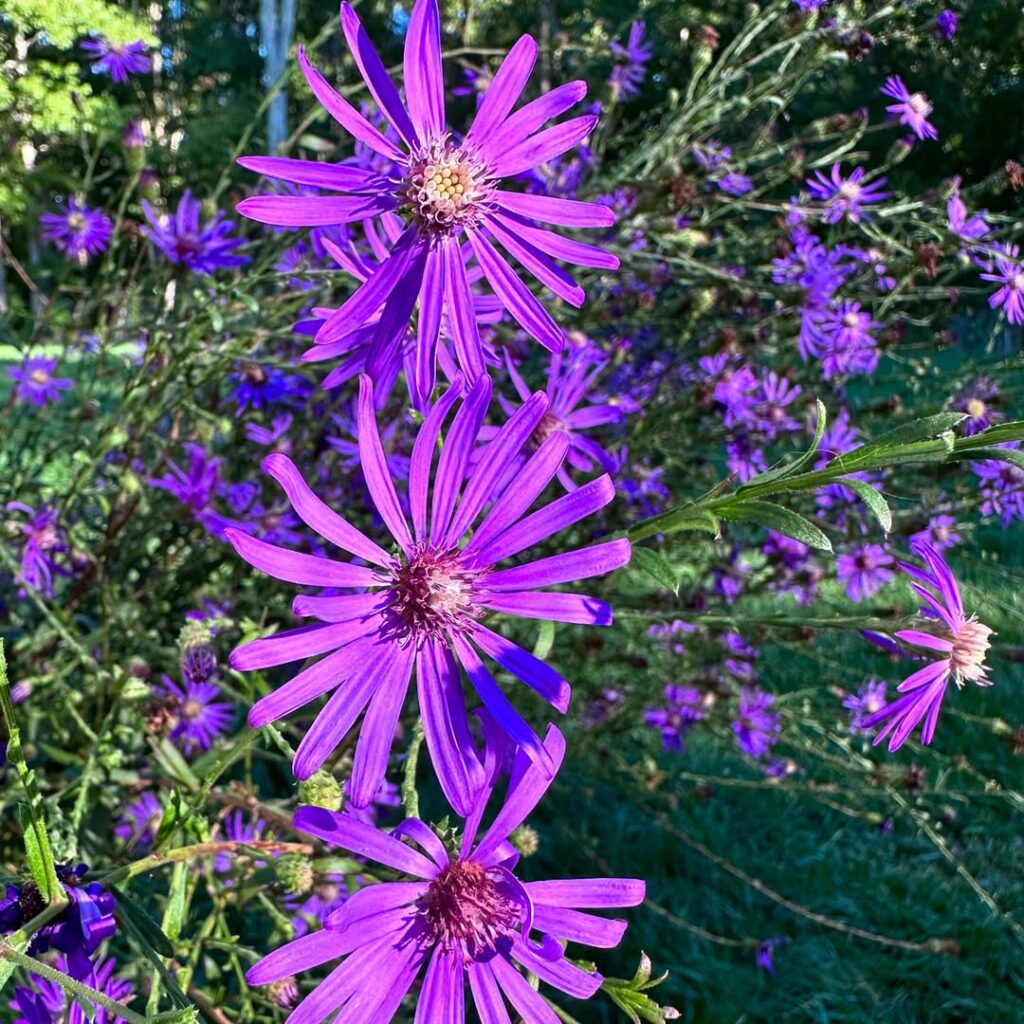
New England Aster is a stunning native wildflower that brings vibrant purple blooms to Massachusetts landscapes from August through November. Growing 1-4 feet tall with clusters of deep purple flowers featuring up to 100 ray petals, this robust perennial provides essential late-season color when many other plants are fading.
This ecological powerhouse attracts numerous pollinators including bees and butterflies while serving as a host plant for Crescent butterflies. With strong, mostly unbranched stems and lance-shaped leaves, New England Aster thrives in various conditions and is one of 27 native aster species indigenous to Massachusetts, making it an excellent choice for naturalized gardens and wildlife habitats. As the plant matures, it loses lower leaves naturally, which is why it works best positioned as a backdrop for shorter plants in mixed perennial borders.
- Hardiness: Zones 4-8, native to Massachusetts
- Light: Full sun to part sun
- Water: Adaptable from wet conditions to dry soil
- Soil: Tolerates various soil types including sand
- Fertilizer: Low maintenance, typically no fertilizer needed
- Pest/Disease Resistance: Generally resistant with few serious issues
- Growth Rate: Moderate, forms clumps with multiple erect stems
Wild Columbine (Aquilegia Canadensis)
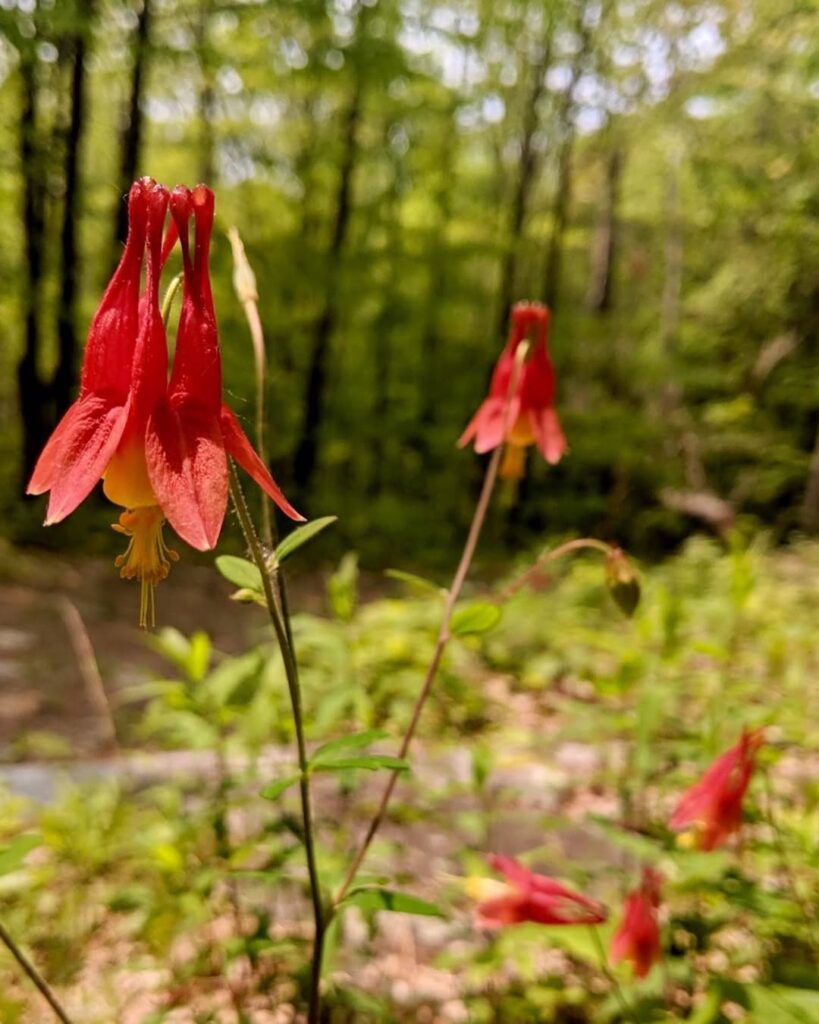
Wild Columbine (Aquilegia canadensis) is a striking native perennial that brings vibrant color to Massachusetts shade gardens. This erect, branching plant grows up to 3 feet tall and produces distinctive nodding flowers resembling dangling lanterns – red on the outside with bright yellow interiors and five long spurs filled with nectar. The delicate foliage features three-leaflet leaves with rounded lobes that remain evergreen in moderate climates.
An excellent choice for woodland gardens and naturalized areas, Wild Columbine thrives in the challenging conditions where many plants struggle. It serves as an essential nectar source for ruby-throated hummingbirds and other pollinators, while finches and buntings feast on its seeds. This moderately deer-resistant plant typically flowers in its second year and performs exceptionally well in container gardens as a saucerless pot plant. The plant also serves as a host plant for the Columbine Duskywing butterfly, supporting local ecosystems.
- Hardiness: Cold and heat tolerant, evergreen unless temperatures exceed 110°F or drop below -10°F
- Light: Part shade to shade preferred; can adapt to open woodlands but not recommended for continuous full sun
- Water: Drought tolerant once established
- Soil: Well-drained, sandy soils preferred; favors sweet, lime-rich soils over acidic conditions
- Fertilizer: Avoid rich garden soil as it can weaken stems and shorten lifespan
- Pest/Disease Resistance: Moderately deer resistant with good overall pest resistance
- Growth Rate: Moderate; flowers typically appear in second year after planting
Black-Eyed Susan (Rudbeckia)
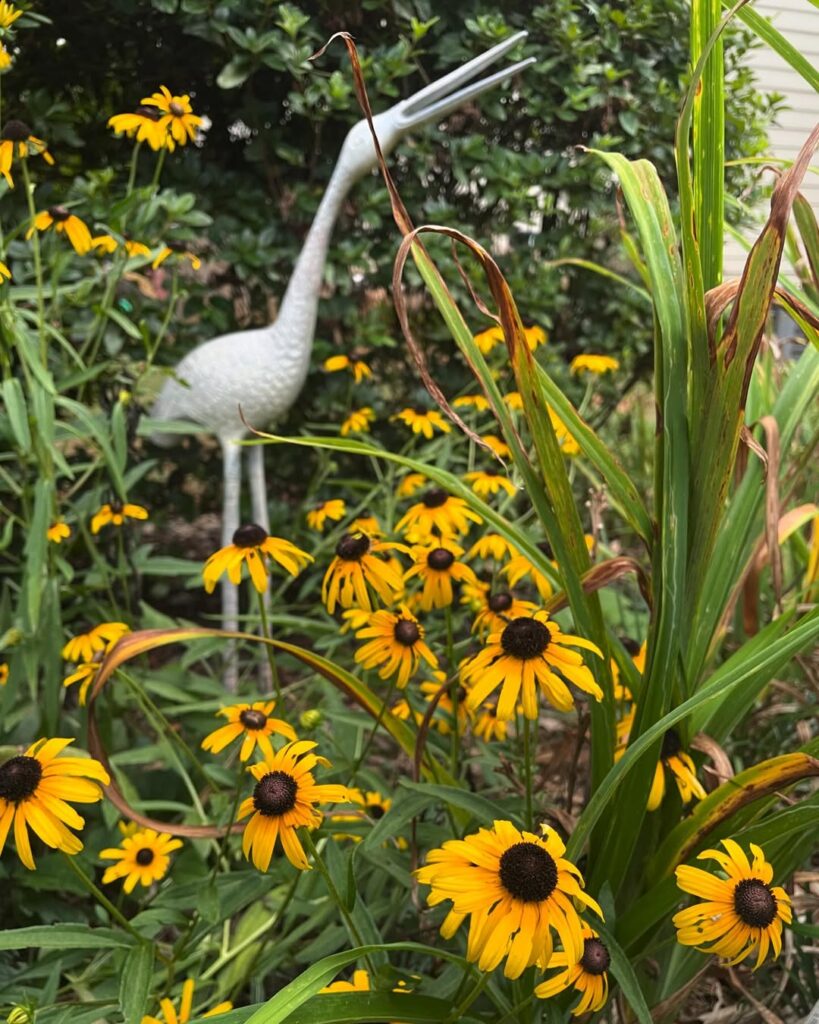
Black-eyed Susan (Rudbeckia hirta) is a beloved native Massachusetts wildflower featuring cheerful daisy-like blooms with golden yellow petals surrounding distinctive dark brown centers. This herbaceous perennial grows 1-2+ feet tall with coarse, bristly stems and leaves, producing 2-3 inch flowers from July through August.
Beyond its ornamental appeal, Black-eyed Susan serves as an ecological powerhouse, attracting pollinators during peak summer months while providing seeds for birds through fall and winter. Its drought tolerance and adaptability to various soil conditions make it an excellent choice for prairie restoration, erosion control, and low-maintenance native plant gardens throughout Massachusetts. The native variety features coarsely toothed ovate to rhombic-oval leaves that distinguish it from the introduced variety commonly found in gardens.
- Hardiness: Native perennial, cold hardy in Massachusetts
- Light: Full sun (6+ hours daily), tolerates partial shade
- Water: Drought tolerant once established, moderate water needs
- Soil: Well-drained loamy, sandy, or clay soils
- Fertilizer: Low maintenance, functions as nitrogen fixer
- Pest/Disease Resistance: Generally resistant to most pests and diseases
- Growth Rate: Moderate growth rate, spreads naturally in suitable conditions
Wild Lupine (Lupinus Perennis)

Wild Lupine (Lupinus perennis) is a stunning native wildflower that reaches 18-24 inches tall and produces bold spikes of blue to purple pea-like flowers from late spring to early summer. This legume family member features distinctive palmate leaves and serves as the exclusive host plant for the federally endangered Karner Blue butterfly, making it essential for conservation efforts.
Beyond its ecological importance, Wild Lupine creates tremendous visual impact when mass planted in garden borders, wildflower meadows, or butterfly gardens. As a nitrogen-fixing plant, it naturally improves soil quality while attracting hummingbirds, native bees, and Monarch butterflies. Its upright form and fine-textured emerald green foliage add structural interest to naturalistic plantings throughout the growing season. Annual fall mowing is recommended to score seed coats and promote germination for establishing sustainable populations.
- Hardiness: USDA zones 3-8
- Light: Full sun in northern regions, partial shade in southern locations
- Water: Dry to medium moisture, requires good drainage
- Soil: Well-drained, sandy soils preferred; acidic to circumneutral pH 6.8-7.2
- Fertilizer: None needed; fixes nitrogen naturally as a legume
- Pest/Disease Resistance: Generally deer resistant; minimal pest issues
- Growth Rate: Moderate; perennial that establishes well in suitable conditions
Massachusetts Native Shade Trees
Massachusetts offers diverse native shade trees suited to various landscape needs, from towering maples and evergreens to flowering varieties, moisture-loving species, and smaller understory trees. These native trees serve as important keystone species that support significant numbers of caterpillars and other wildlife, making them essential for maintaining biodiversity in local ecosystems.
Eastern White Pine (Pinus Strobus)
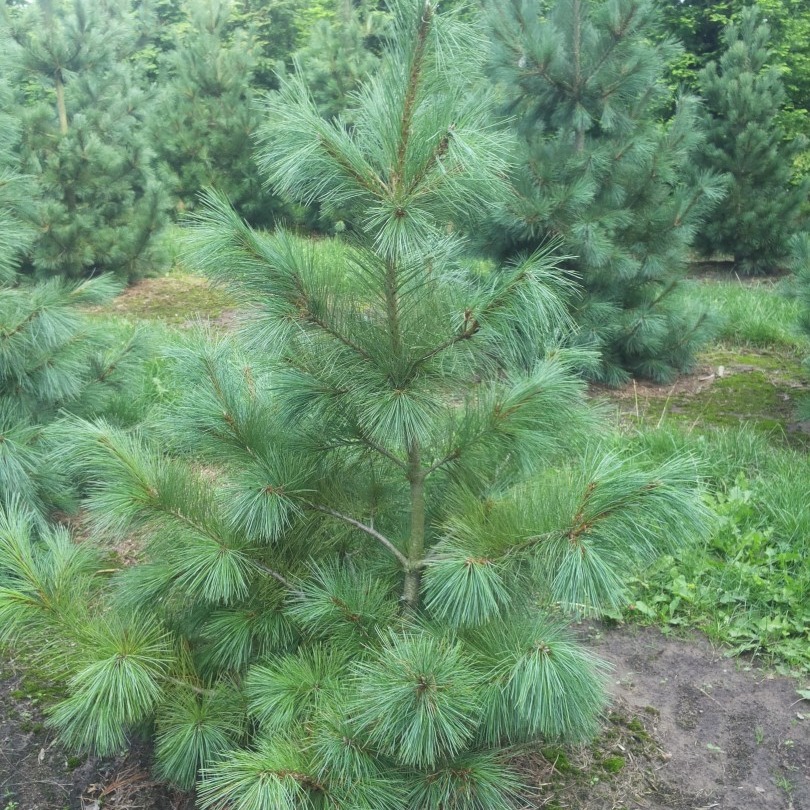
The Eastern White Pine is Massachusetts’ tallest native evergreen, reaching heights of 130 feet with distinctive soft needles clustered in groups of five. This valuable timber and landscaping tree features smooth greenish-gray bark on young specimens that develops into deeply furrowed, scaly blocks as it matures. Its classic upswept branching pattern creates a recognizable silhouette that often emerges above the forest canopy.
With reasonably rapid growth compared to other northern conifers, the Eastern White Pine evolves from a conic crown shape to rounded or irregular forms at maturity. The tree produces distinctive 4-8 inch long cones with pointed white tips that ripen from green to yellow-brown in the fall of their second season. Its fire resistance and ability to reseed burned areas, combined with excellent shade provision and landscaping value, make it one of the most important native evergreens for both ecological restoration and ornamental use. The species serves as an excellent screening tree when planted in rows along property boundaries or for creating privacy barriers.
- Hardiness: Zones 3-8, well-adapted to New England climate conditions
- Light: Full sun to partial shade, performs best in full sun locations
- Water: Moderate water requirements, drought tolerant once established
- Soil: Well-drained, slightly acidic soils; adaptable to various soil types
- Fertilizer: Low fertilizer needs, benefits from organic matter incorporation
- Pest/Disease Resistance: Susceptible to white pine blister rust; somewhat fire resistant
- Growth Rate: Moderately fast compared to other northern forest conifers
American Beech (Fagus Grandifolia)
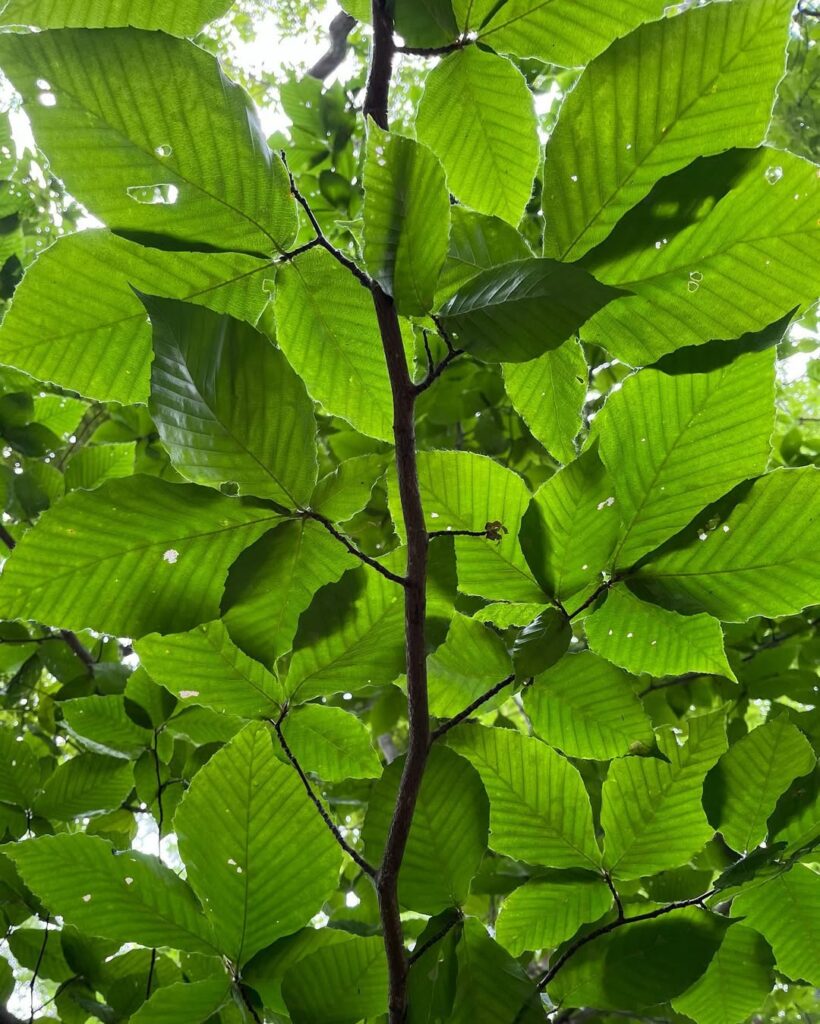
American Beech is a majestic native shade tree that can reach 50-70 feet tall with an equally impressive spread. Distinguished by its smooth, silvery-gray bark that remains attractive throughout its lifespan, this deciduous tree features dark green leaves that turn golden-brown in fall and often persist into winter. The beechnuts provide valuable food for wildlife, while the tree’s tendency to form colonies through root suckers creates complex forest habitats. Though slow-growing, American Beech develops into a long-lived specimen with a distinctive wide canopy and low-hanging branches that often touch the ground. Mature specimens may develop bark blisters from Nectria fungus, which can weaken the tree over time.
- Hardiness: Zones 4-9
- Light: Full sun to part shade
- Water: Moderate; prefers well-drained conditions
- Soil: Well-drained, average soils; adaptable to various soil types
- Fertilizer: Not typically required; benefits from natural forest floor nutrients
- Pest/Disease Resistance: Deer and rabbit resistant; susceptible to beech leaf disease
- Growth Rate: Slow
Sugar Maple (Acer Saccharum)
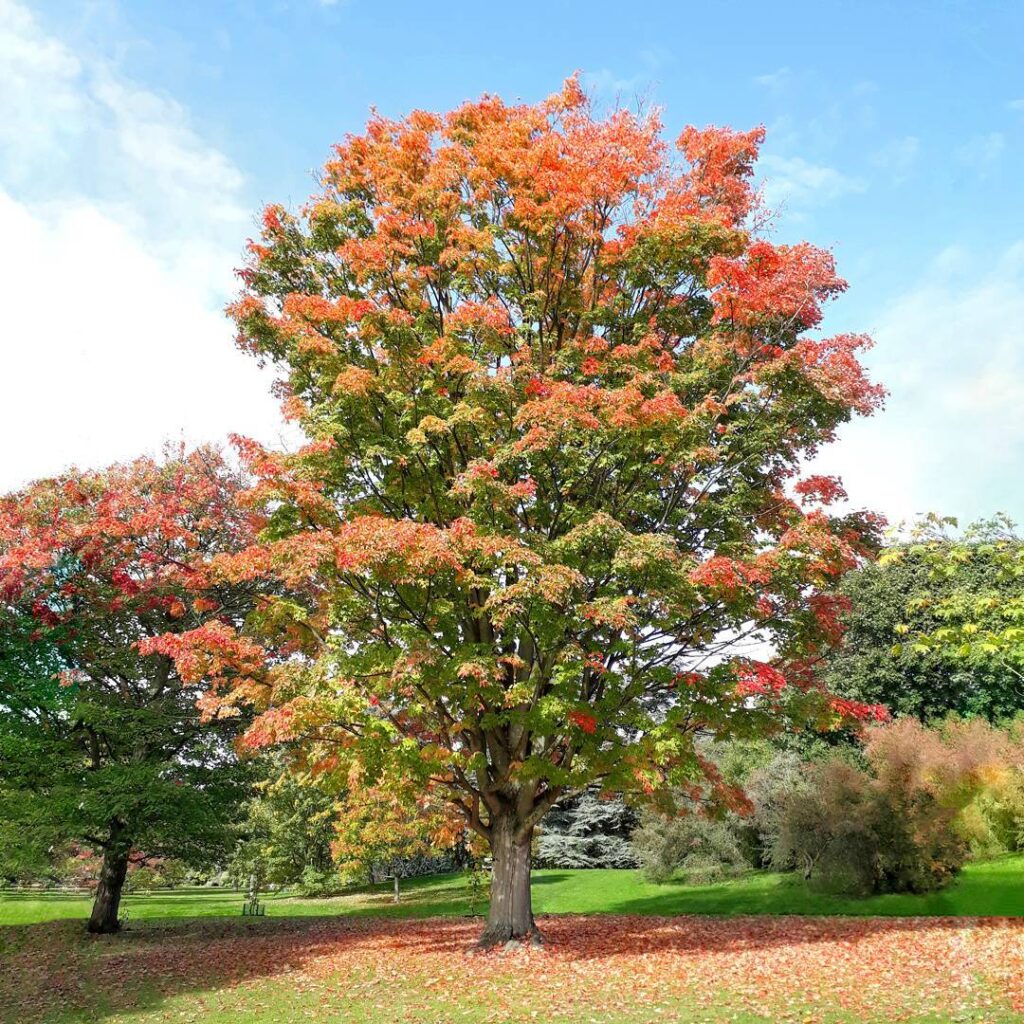
The Sugar Maple (Acer saccharum) is a magnificent native Massachusetts shade tree renowned for its spectacular fall foliage and maple syrup production. This stately tree typically reaches 60-75 feet at maturity with a dense, oval to rounded crown that provides excellent shade. As a cornerstone species of New England’s hardwood forests, it displays iconic palmate leaves up to 7.9 inches wide that transform into brilliant gold, orange, and red hues each autumn.
Beyond its ornamental value, the Sugar Maple holds tremendous economic and cultural significance as the primary source of maple syrup and high-quality hardwood lumber. Many of today’s magnificent specimens were actually planted by colonial settlers and still thrive centuries later, featuring massive trunks and deeply fissured bark that tell the story of New England’s agricultural heritage. Its dense canopy and symmetrical form make it an outstanding choice for large landscapes and parks, while its ecological importance as a host plant for native insects and food source for wildlife cannot be overstated.
- Hardiness: USDA Zone 3b, cold hardy through New England winters
- Light: Full sun to partial shade
- Water: Moist, well-drained conditions; sensitive to drought
- Soil: Well-drained, slightly acidic soils; dislikes poorly drained or compacted soil
- Fertilizer: Minimal requirements in natural forest settings
- Pest/Disease Resistance: Good resistance but sensitive to air pollution and urban stresses
- Growth Rate: Moderate; 10-year-old trees average 20 feet in height
Northern Red Oak (Quercus Rubra)

The Northern Red Oak (Quercus rubra) is one of Massachusetts’ most common and widespread native shade trees, reaching heights of up to 92 feet with a distinctive broad, rounded crown. This deciduous oak features characteristic bark with shiny-striped ridges and supports local wildlife through its acorn production, which develops over two growing seasons.
As a popular landscape choice, Northern Red Oak offers excellent shade, attractive fall foliage, and strong branching patterns. It’s easily transplanted, low-maintenance once established, and demonstrates remarkable longevity with lifespans reaching up to 400 years. The species plays a vital ecological role in Massachusetts forests while serving as valuable timber. Mature trees provide important wildlife habitat, with mammals like raccoons using hollows in the trunks for dens.
- Hardiness: Native to Eastern North America, well-adapted to Massachusetts climate zones
- Light: Full sun preferred for ideal growth and development
- Water: Drought tolerant once established, prefers well-drained conditions
- Soil: Acidic, fertile, sandy to loamy soils; thrives in deep, well-drained sites
- Fertilizer: Low-maintenance, typically doesn’t require supplemental fertilization
- Pest/Disease Resistance: Generally resistant but may be affected by gypsy moth defoliation
- Growth Rate: Moderate to fast-growing; can reach 16-20 feet in 10 years under ideal conditions
American Chestnut (Castanea Dentata)

The American Chestnut was once one of Massachusetts’ most magnificent native trees, dominating the oak-chestnut forests throughout New England. These fast-growing deciduous giants could reach massive proportions, with trunks 2-5 feet in diameter, and produced valuable edible nuts that fed both wildlife and humans for centuries.
Tragically, this iconic species was nearly wiped out by chestnut blight in the early 1900s, with an estimated 3-4 billion trees lost. Today, it exists primarily as root sprouts that rarely mature due to recurring infections. The bark yielded tannins that were historically important for leather processing and other industrial uses. Conservation efforts are underway to develop blight-resistant varieties and restore this ecologically important native tree to Massachusetts forests.
- Hardiness: Zones 4-8, native to eastern North America including Massachusetts
- Light: Tolerates full sun, part shade, and shade conditions
- Water: Medium water requirements, prefers moist but well-drained soils
- Soil: Acidic soils with pH below 6.8, no tolerance for high calcium carbonate
- Fertilizer: Minimal requirements in native forest settings
- Pest/Disease Resistance: Highly susceptible to chestnut blight and ink disease
- Growth Rate: Fast-growing when healthy, can reach elevations up to 4,000 feet
Massachusetts Native Shrub Varieties
Massachusetts offers diverse native shrubs that provide wildlife habitats, stunning seasonal blooms, adapt to various growing conditions, prevent erosion, and deliver year-round landscape interest. Native shrubs are available in multiple pot sizes including 18-count plugs, 32-count plugs, and newer options like 38-count deep plugs to meet different planting needs.
Spicebush (Lindera Benzoin)

Spicebush (Lindera benzoin) is a deciduous native shrub that brings multi-season interest to Massachusetts landscapes. This woodland species produces clusters of small yellow flowers in early spring before its leaves emerge, followed by light green summer foliage that transforms to brilliant golden-yellow in fall. Female plants bear bright red drupes that provide valuable food for migrating songbirds.
Beyond its ornamental value, spicebush serves as a significant host plant for the Spicebush Swallowtail butterfly and supports various native pollinators. The entire plant emits a distinctive spicy, citrusy fragrance when crushed, earning it the common name “wild allspice.” Its leaves and twigs can be used for herbal tea, while the berries serve as a spice substitute. This tall shrub naturally thrives in bottomlands and moist areas throughout its native range.
- Hardiness: USDA Zones 4-9
- Light: Shade to full sun (tolerates deep shade)
- Water: Moist to medium moisture; drought tolerant once established
- Soil: Adaptable to sandy loam, loam, and clay; prefers well-draining soil
- Fertilizer: Low maintenance; no fertilizer needed in native settings
- Pest/Disease Resistance: Excellent resistance; few serious issues
- Growth Rate: Moderate; reaches 6-12 feet in sun, 3-5 feet in shade
Elderberry (Sambucus Canadensis)
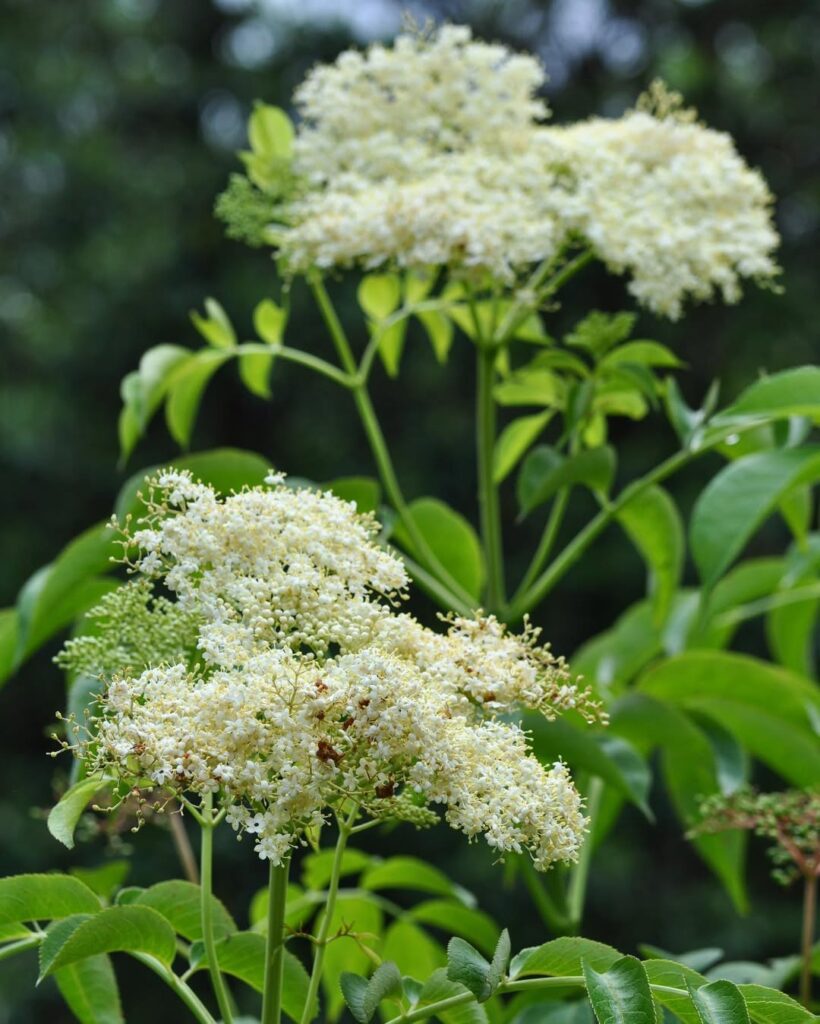
Elderberry (Sambucus canadensis) is a versatile native shrub that thrives throughout Massachusetts and New England. This deciduous woody plant reaches 5-12 feet in height with an equally impressive spread, making it an excellent choice for naturalistic plantings and wildlife gardens.
The shrub produces striking white flower clusters up to 10 inches wide from May through July, followed by dark purple-black berries rich in vitamin C. Its compound leaves and fast growth rate make it ideal for hedgerows or screening. Elderberry adapts well to various Massachusetts soil conditions and provides exceptional ecological value, attracting pollinators to its flowers and birds to its nutritious berries. The plant features distinctive leaves with serrate margins that have medium to coarse teeth along their edges.
- Hardiness: Zones 3-8, well-suited to Massachusetts climate
- Light: Full sun to partial shade
- Water: Medium to wet conditions, tolerates occasional flooding
- Soil: Adaptable to clay, loam, sand, and high organic matter soils; pH 5.0-8.0
- Fertilizer: Low requirements, thrives in naturally fertile soils
- Pest/Disease Resistance: Generally resistant with few serious issues
- Growth Rate: Fast-growing with vigorous root system producing new shoots
Winterberry Holly (Ilex Verticillata)
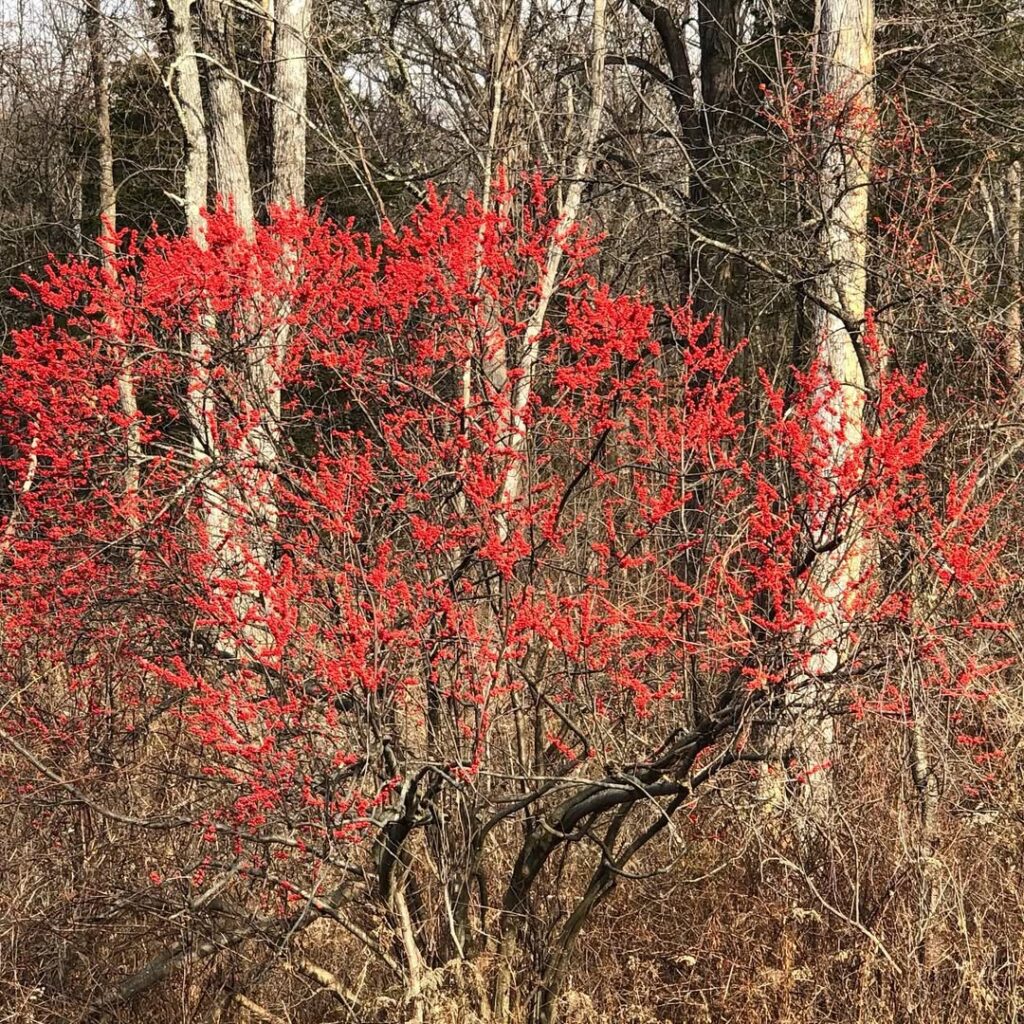
Winterberry Holly is a deciduous native shrub that grows 6-10 feet tall, thriving in Massachusetts’ wetland margins, shorelines, and swampy areas. This adaptable plant features lustrous dark green leaves and produces striking bright red berry clusters on female plants that persist through winter, providing critical food for birds and small mammals.
The shrub requires both male and female plants for berry production, with recommended male pollinators like ‘Jim Dandy’ serving 10-20 female plants within 50 feet. Compact cultivars such as ‘Red Sprite’ mature at 3-5 feet, making them perfect for smaller gardens while maintaining the species’ exceptional winter ornamental value. The plant’s striking appearance becomes particularly pronounced after deciduous leaves drop in autumn, revealing the brilliant red berries against bare branches.
- Hardiness: USDA Zones 3-9
- Light: Part shade to full sun (full sun for best fruiting)
- Water: Moist conditions preferred; tolerates wet to moderately dry sites
- Soil: Moist, acidic soils rich in organic matter; tolerates various soil types
- Fertilizer: Low maintenance; no special fertilizer requirements
- Pest/Disease Resistance: Excellent; no major pest or disease problems; deer resistant
- Growth Rate: Moderate
Serviceberry (Amelanchier Canadensis)
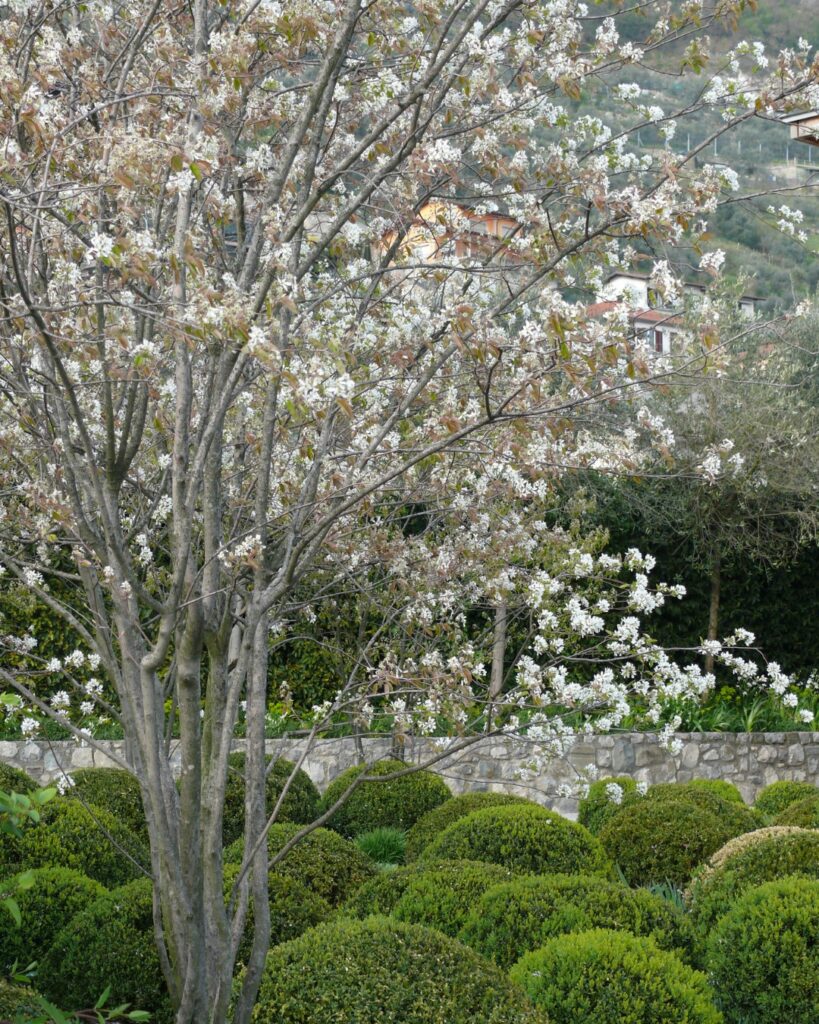
Serviceberry (Amelanchier canadensis) is a graceful native Massachusetts shrub that transforms into a small tree reaching 15-25 feet tall. This versatile plant offers exceptional three-season interest with fragrant white spring flowers that bloom as leaves emerge, followed by edible purple-black berries in summer and brilliant reddish-orange fall foliage. Also known as shadbush or Juneberry, it naturally grows in wetlands and understory areas throughout eastern North America’s coastal and Piedmont regions.
The serviceberry’s elegant arching form features smooth gray bark with dark vertical stripes and multiple trunks. Its common name derives from its spring blooming period coinciding with shad fish migration in New England rivers. Beyond ornamental value, this shrub serves as essential wildlife habitat, providing nectar for pollinators and berries for birds while offering edible fruit for human consumption. The serviceberry supports numerous butterfly species and attracts various birds, contributing to biologically diverse landscapes.
- Hardiness: Zones 3-8, well-adapted to Massachusetts climate
- Light: Part shade preferred; full sun acceptable with adequate moisture
- Water: Moist, well-drained conditions; adapts to both wet and moderately dry sites
- Soil: Sandy loam preferred; tolerates various soil types including somewhat clay-heavy soils
- Fertilizer: Minimal requirements; benefits from organic matter incorporation
- Pest/Disease Resistance: Generally good resistance; occasional issues with rust or leaf spot
- Growth Rate: Moderate growth rate with graceful, naturally arching form
Wild Rose (Rosa Carolina)
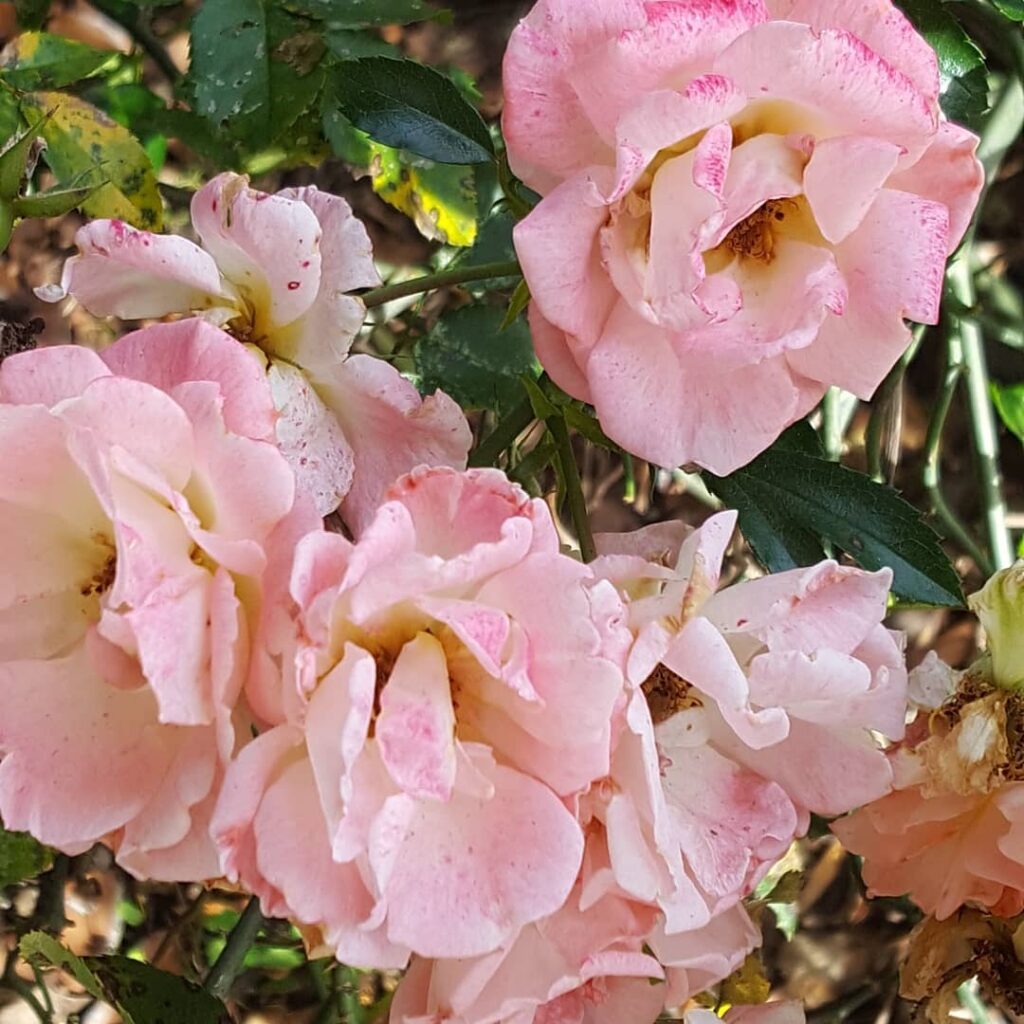
Wild Rose (Rosa carolina) is a versatile native shrub that brings natural beauty to Massachusetts landscapes while supporting local ecosystems. Growing 1-3 feet tall, this deciduous perennial produces fragrant pink flowers in late spring and early summer, followed by bright red rosehips that persist through winter. As a member of the rose family, it offers excellent wildlife value, supporting native pollinators and providing winter food for birds.
This hardy native thrives in challenging conditions where non-native ornamentals might struggle, making it ideal for coastal areas, hell strips, and naturalized settings. Its thorny stems and adaptable nature make it suitable for hedging, erosion control, or as groundcover in rain gardens and disturbed areas. The low-growing shrub structure makes it particularly effective for borders and mass plantings where consistent height and coverage are desired.
- Hardiness: USDA zones 4-9, cold hardy and salt tolerant
- Light: Full sun to partial shade; most shade-tolerant rose species
- Water: Adaptable to dry, moist, or wet conditions; drought tolerant
- Soil: Prefers acidic, well-drained rocky or sandy soils; tolerates various soil types
- Fertilizer: Low maintenance; no fertilizer requirements
- Pest/Disease Resistance: Generally resistant to common rose diseases
- Growth Rate: Moderate growth rate; spreads by underground rhizomes
Selecting the Right Native Plants for Your Garden
How do you choose the perfect native plants that’ll thrive in your Massachusetts garden while supporting local wildlife? Start by evaluating your site’s specific conditions: sun exposure, soil moisture, and space availability. Native plant benefits include drought tolerance, zero fertilizer requirements, and minimal maintenance once established.
Consider your garden design goals carefully. Include both nectar sources like Wild Bergamot and host plants such as Butterfly Weed for complete pollinator lifecycle support. Select plants with staggered bloom times, from early Mayflower to late-season Goldenrod, ensuring season-long resources.
Match plants to conditions using Massachusetts’ searchable native plant lists, which categorize species by growing requirements. These adapted species provide natural defenses against local pests and diseases, reducing the need for chemical interventions in your garden.
Frequently Asked Questions
When Is the Best Time to Plant Native Species in Massachusetts?
For ideal planting timing, you’ll find late fall offers the best seasonal considerations. You should plant native meadow seeds then, while you can transplant perennials in early spring when soil reaches 45-65°F.
How Do I Propagate Massachusetts Native Plants From Seeds?
Don’t put all your eggs in one basket—diversify your seed collection from multiple native species in fall. Master germination techniques like cold stratification and scarification, then sow outdoors or use winter sowing containers.
What Native Plants Attract Butterflies and Pollinators in Massachusetts?
You’ll create stunning butterfly gardens with native milkweeds, wild columbine, and New England asters. These pollinator habitats thrive when you plant goldenrods, wild lupine, and mountain mint for year-round nectar sources.
Are There Native Alternatives to Common Invasive Plants in Massachusetts?
You’ll find excellent invasive plant alternatives throughout Massachusetts, from Barren Strawberry replacing English Ivy to Sweet Pepperbush substituting burning bush. These natives offer significant ecological benefits while requiring less maintenance than invasive species.
How Much Do Native Massachusetts Plants Typically Cost Compared to Non-Natives?
Native plant pricing runs $12-$18 per pot versus $2.50 for non-natives initially. However, your cost comparison should consider long-term savings since natives require less maintenance, watering, and replacement over time.
